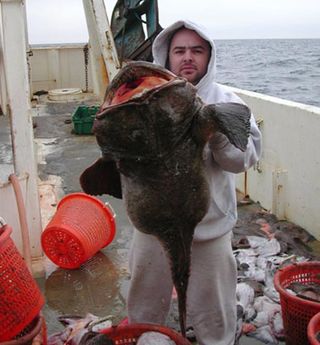Data Tags Shine Light on the Mysterious Monkfish

Monkfish are ferocious-looking creatures sometimes nicknamed "the poor man's lobster" thanks to their muscular, firm-when-cooked tails. But in spite of their relatively recent rise in popularity on Americans' dinner plates, their biology and behavior are poorly understood.
Now a team of researchers has received the first substantial data from a computer chip-toting monkfish. The data is part of a study in which researchers have implanted data storage tags under the skin of about 190 monkfish so far. These tags record depth and temperature every 10 minutes for up to five years, according to Anne Richards, a research fishery biologist with the U.S. National Oceanic and Atmospheric Administration. [Image of captured monkfish]
The team hopes the tags will reveal more about the depths at which the fish live, where they spawn and the seasonal migrations these angler fish seem to undertake along the Atlantic coast.
Since the study began, other fish have also been returned to the researchers, who are offering a $500 reward per fish. However, the fish they received in July, eight months after it was tagged, was the first to carry usable data.
Although the tag does not contain direct information on location – that would require light, which is not available at the depths at which monkfish live – it does reveal that the bottom-dwelling fish spent substantial time at the surface and in the water column, a behavior also seen in data obtained from a single monkfish in separate research.
It's possible the monkfish are swimming up to catch a current that will carry them along their migration route, using their large pectoral fins as sails, according to Richards.
The data on the chip also indicated that the fish did not go deeper than about 98 feet (30 meters). This came as a surprise to researchers, who believed monkfish traveled to deeper water during the cold season.
Sign up for the Live Science daily newsletter now
Get the world’s most fascinating discoveries delivered straight to your inbox.
"We won't know if this fish was an 'oddball' in this regard until we get more returns," Richards told LiveScience in an e-mail.
Federal fisheries surveys, conducted for more than 40 years, have indicated the monkfish's whereabouts tend to shift with the temperature, suggesting they migrate.
"It looks like some part of the population comes into the southern part of the (continental) shelf, like off North Carolina and Virginia, in early spring then moves out of there. Whether they move back into deeper water or they move north we don’t know," she said. The seasonal movement is not nearly as pronounced in the north, according to Richards.
Another common name for monkfish is "all mouth" because this anglerfish fish sits, partially buried, at the bottom of the ocean, using a lure to attract prey. Then it opens its mouth suddenly, creating a vacuum to suck in the meal.
In the late 1980s, fisherman began catching more monkfish, and by the mid-1990s, the catch had soared. Monkfish has become the most economically valuable finfish in the northeast, surpassing the depleted cod, haddock and flounder fisheries, according to Richards.
- Top 10 Most Incredible Animal Journeys
- Gallery: Freaky Fish
- The World's Freakiest Looking Animals

